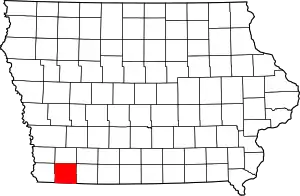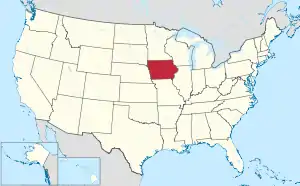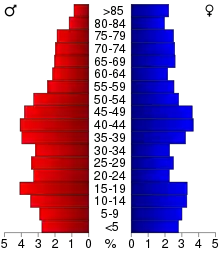Page County, Iowa
Page County is a county located in the U.S. state of Iowa. As of the 2010 census, the population was 15,932.[1] The county seat is Clarinda.[2] The county is named in honor of Captain John Page of the 4th U.S. Infantry, who was mortally wounded in the Battle of Palo Alto.
Page County | |
|---|---|
 The courthouse in Clarinda is on the NRHP. | |
 Location within the U.S. state of Iowa | |
 Iowa's location within the U.S. | |
| Coordinates: 40°44′17″N 95°08′53″W | |
| Country | |
| State | |
| Founded | February 24, 1847 |
| Named for | John Page |
| Seat | Clarinda |
| Largest city | Clarinda |
| Area | |
| • Total | 535 sq mi (1,390 km2) |
| • Land | 535 sq mi (1,390 km2) |
| • Water | 0.5 sq mi (1 km2) 0.1% |
| Population (2010) | |
| • Total | 15,932 |
| • Estimate (2018) | 15,249 |
| • Density | 30/sq mi (11/km2) |
| Time zone | UTC−6 (Central) |
| • Summer (DST) | UTC−5 (CDT) |
| Congressional district | 3rd |
| Website | www |
Geography
According to the U.S. Census Bureau, the county has a total area of 535 square miles (1,390 km2), of which 535 square miles (1,390 km2) is land and 0.5 square miles (1.3 km2) (0.1%) is water.[3]
Major highways
 U.S. Route 71
U.S. Route 71 Iowa Highway 2
Iowa Highway 2 U.S. Route 59
U.S. Route 59 Iowa Highway 48
Iowa Highway 48
Adjacent counties
- Montgomery County (north)
- Taylor County (east)
- Nodaway County, Missouri (southeast)
- Atchison County, Missouri (southwest)
- Fremont County (west)
Demographics
| Historical population | |||
|---|---|---|---|
| Census | Pop. | %± | |
| 1850 | 551 | — | |
| 1860 | 4,419 | 702.0% | |
| 1870 | 9,975 | 125.7% | |
| 1880 | 19,667 | 97.2% | |
| 1890 | 21,341 | 8.5% | |
| 1900 | 24,187 | 13.3% | |
| 1910 | 24,002 | −0.8% | |
| 1920 | 24,137 | 0.6% | |
| 1930 | 25,904 | 7.3% | |
| 1940 | 24,887 | −3.9% | |
| 1950 | 23,921 | −3.9% | |
| 1960 | 21,023 | −12.1% | |
| 1970 | 18,537 | −11.8% | |
| 1980 | 19,063 | 2.8% | |
| 1990 | 16,870 | −11.5% | |
| 2000 | 16,976 | 0.6% | |
| 2010 | 15,932 | −6.1% | |
| 2018 (est.) | 15,249 | [4] | −4.3% |
| U.S. Decennial Census[5] 1790-1960[6] 1900-1990[7] 1990-2000[8] 2010-2018[1] | |||
2010 census
The 2010 census recorded a population of 15,932 in the county, with a population density of 29.7895/sq mi (11.5018/km2). There were 7,181 housing units, of which 6,393 were occupied.[9]
2000 census

At the 2000 census there were 16,976 people, 6,708 households, and 4,460 families in the county. The population density was 32 people per square mile (12/km2). There were 7,302 housing units at an average density of 14 per square mile (5/km2). The racial makeup of the county was 96.11% White, 1.66% Black or African American, 0.49% Native American, 0.48% Asian, 0.01% Pacific Islander, 0.49% from other races, and 0.77% from two or more races. 1.56%.[10] were Hispanic or Latino of any race.
Of the 6,708 households 28.20% had children under the age of 18 living with them, 55.50% were married couples living together, 8.10% had a female householder with no husband present, and 33.50% were non-families. 29.90% of households were one person and 15.40% were one person aged 65 or older. The average household size was 2.32 and the average family size was 2.87.
The age distribution was 23.30% under the age of 18, 7.90% from 18 to 24, 26.30% from 25 to 44, 22.80% from 45 to 64, and 19.80% 65 or older. The median age was 40 years. For every 100 females there were 102.70 males. For every 100 females age 18 and over, there were 101.80 males.
The median household income was $35,466 and the median family income was $42,446. Males had a median income of $32,549 versus $21,526 for females. The per capita income for the county was $16,670. About 8.10% of families and 12.50% of the population were below the poverty line, including 17.90% of those under age 18 and 7.60% of those age 65 or over.
Communities
Cities
Townships
Population ranking
The population ranking of the following table is based on the 2010 census of Page County.[11]
† county seat
| Rank | City/Town/etc. | Municipal type | Population (2010 Census) |
|---|---|---|---|
| 1 | † Clarinda | City | 5,572 |
| 2 | Shenandoah (partially in Fremont County) | City | 5,150 (5,150 total) |
| 3 | Essex | City | 798 |
| 4 | College Springs | City | 214 |
| 5 | Coin | City | 193 |
| 6 | Shambaugh | City | 191 |
| 7 | Braddyville | City | 159 |
| 8 | Yorktown | City | 85 |
| 9 | Northboro | City | 58 |
| 10 | Blanchard | City | 38 |
| 11 | Hepburn | City | 23 |
Politics
| Year | Republican | Democratic | Third Parties |
|---|---|---|---|
| 2016 | 69.5% 4,893 | 25.7% 1,807 | 4.9% 344 |
| 2012 | 61.4% 4,348 | 36.9% 2,613 | 1.7% 118 |
| 2008 | 59.1% 4,351 | 39.4% 2,900 | 1.5% 108 |
| 2004 | 69.8% 5,243 | 29.4% 2,211 | 0.8% 59 |
| 2000 | 65.0% 4,588 | 32.5% 2,293 | 2.5% 178 |
| 1996 | 57.3% 4,032 | 31.5% 2,220 | 11.2% 791 |
| 1992 | 50.2% 3,670 | 26.7% 1,951 | 23.1% 1,689 |
| 1988 | 67.4% 4,583 | 32.1% 2,185 | 0.5% 35 |
| 1984 | 75.1% 5,876 | 24.5% 1,914 | 0.5% 38 |
| 1980 | 71.9% 5,618 | 22.7% 1,772 | 5.4% 420 |
| 1976 | 64.1% 5,343 | 34.4% 2,865 | 1.5% 127 |
| 1972 | 76.4% 6,200 | 22.1% 1,790 | 1.5% 122 |
| 1968 | 68.1% 5,907 | 24.5% 2,128 | 7.4% 644 |
| 1964 | 51.9% 4,775 | 47.8% 4,402 | 0.4% 32 |
| 1960 | 69.7% 7,089 | 30.2% 3,075 | 0.1% 8 |
| 1956 | 71.0% 7,380 | 28.9% 3,001 | 0.2% 16 |
| 1952 | 76.5% 8,840 | 23.1% 2,669 | 0.4% 44 |
| 1948 | 60.2% 5,638 | 38.1% 3,567 | 1.8% 169 |
| 1944 | 65.1% 6,300 | 34.1% 3,297 | 0.9% 85 |
| 1940 | 64.0% 7,407 | 35.5% 4,102 | 0.5% 57 |
| 1936 | 58.5% 6,624 | 41.0% 4,646 | 0.5% 53 |
| 1932 | 47.5% 4,512 | 51.2% 4,863 | 1.4% 132 |
| 1928 | 73.3% 7,181 | 25.3% 2,478 | 1.4% 133 |
| 1924 | 65.6% 6,023 | 17.9% 1,643 | 16.5% 1,518 |
| 1920 | 76.1% 6,949 | 21.2% 1,931 | 2.8% 251 |
| 1916 | 60.9% 2,993 | 35.5% 1,747 | 3.6% 177 |
| 1912 | 19.7% 980 | 29.3% 1,462 | 51.0% 2,545 |
| 1908 | 60.8% 3,141 | 33.4% 1,726 | 5.8% 302 |
| 1904 | 71.2% 3,463 | 19.4% 944 | 9.4% 456 |
| 1900 | 60.7% 3,424 | 33.5% 1,889 | 5.9% 330 |
| 1896 | 56.3% 3,213 | 41.9% 2,390 | 1.8% 102 |
See also
References
- "State & County QuickFacts". United States Census Bureau. Archived from the original on June 7, 2011. Retrieved July 20, 2014.
- "Find a County". National Association of Counties. Retrieved June 7, 2011.
- "US Gazetteer files: 2010, 2000, and 1990". United States Census Bureau. February 12, 2011. Retrieved April 23, 2011.
- "Population and Housing Unit Estimates". Retrieved June 25, 2019.
- "U.S. Decennial Census". United States Census Bureau. Retrieved July 20, 2014.
- "Historical Census Browser". University of Virginia Library. Retrieved July 20, 2014.
- "Population of Counties by Decennial Census: 1900 to 1990". United States Census Bureau. Retrieved July 20, 2014.
- "Census 2000 PHC-T-4. Ranking Tables for Counties: 1990 and 2000" (PDF). United States Census Bureau. Retrieved July 20, 2014.
- "Population & Housing Occupancy Status 2010". United States Census Bureau American FactFinder. Retrieved May 22, 2011.
- "U.S. Census website". United States Census Bureau. Retrieved January 31, 2008.
- https://www.census.gov/2010census/
- Leip, David. "Dave Leip's Atlas of U.S. Presidential Elections". uselectionatlas.org. Retrieved April 27, 2018.
